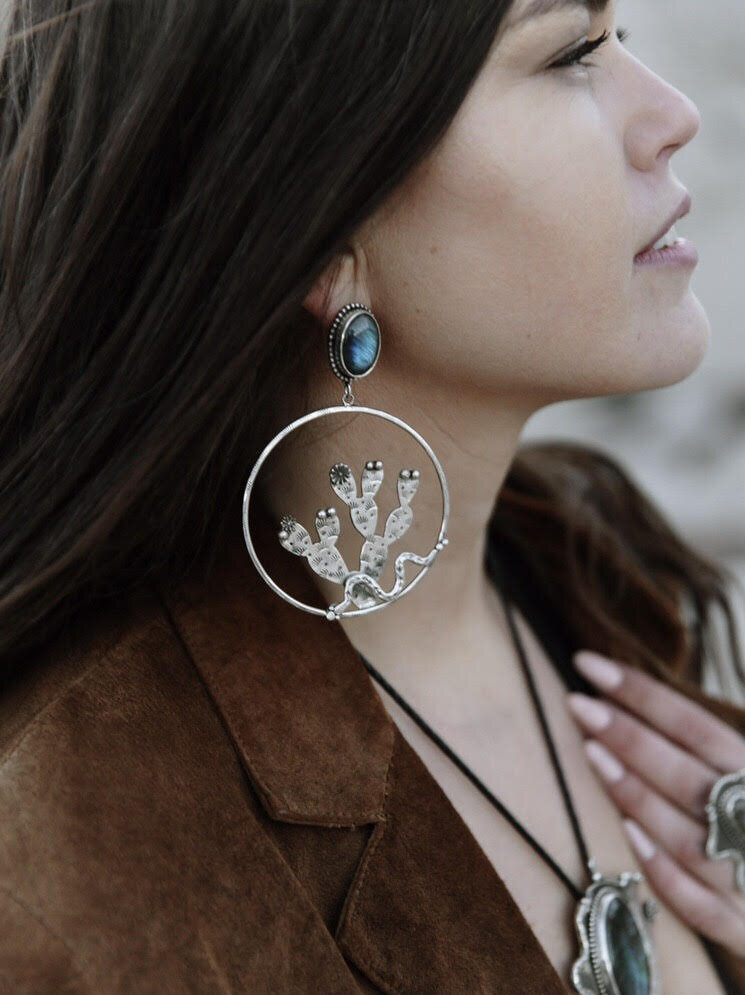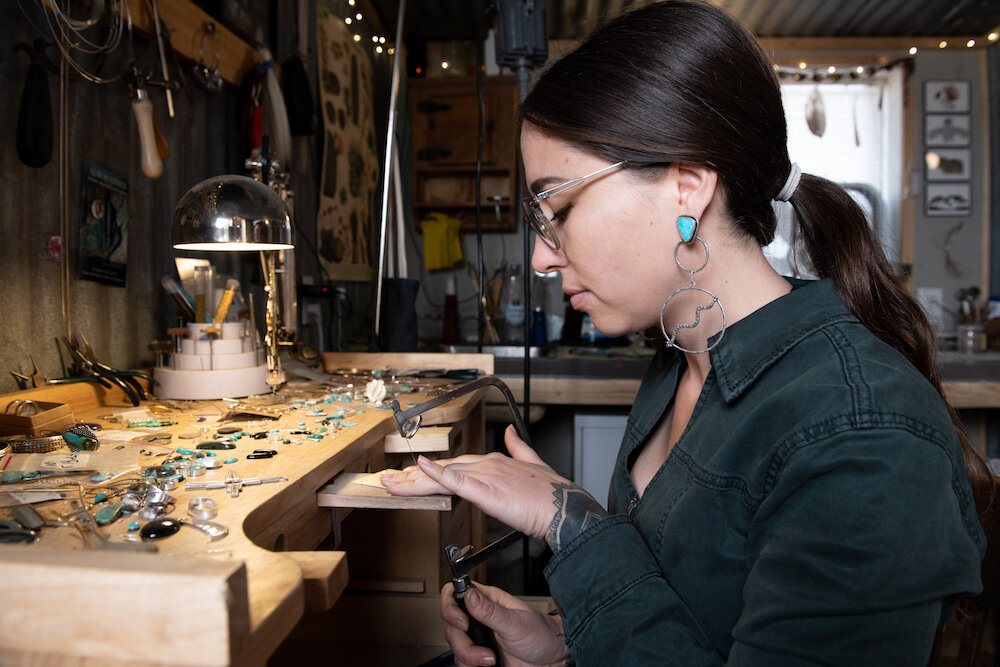Image by Brandon Soder
By: Maria Manuela
Leah Prada Harrison used to have a recurring dream.
In it, she visited her late maternal grandmother at the home she lived in when Leah was a child. Each time, her grandmother greeted her at the door, welcoming her into a bare home. “The whole house was empty. She would walk me through to this room where we used to stay when she would babysit us, and she would open it, and it would be filled with silver jewelry. She would walk me through that threshold, and show me all of these designs and pieces, and I remember being just being really inspired by it when I woke up.”
Today, Leah makes beautiful jewelry in the studio she built on her grandmother’s land in a rural area near Santa Fe, where her family has lived for 8 generations.
Image by Amanda Powell
Her company, Yoté Jewelry, is a journey of self-expression and an homage to her mixed identity. She is Mestiza, primarily Tewa Hispanic, on her mom’s side, and has a white father. “Growing up, especially because I grew up with my mom’s side of the family, it was always this weird identity crisis. I was raised as a minority, but because I was fair skinned and had this white last name it created this weird separation and, I always had this sense of being an outsider looking in.”
Coyoté is a term used amongst Hispanic communities to designate people who aren’t fully Spanish; or people who are mixed. It’s like calling someone a mutt. It’s derogatory, and a term I’ve often heard used against people, not only to hurt them but also imply that being mixed equates to being lower. Leah heard the term in her childhood from her own family. “They always encouraged me to identify as Coyoté vs. claim any part of my white heritage. Some of my cousins were very Hispanic-proud and prejudiced against whites, so they didn’t want a relative to claim any part of that.”
Growing up, especially because I grew up with my mom’s side of the family, it was always this weird identity crisis. I was raised as a minority, but because I was fair skinned and had this white last name it created this weird separation and, I always had this sense of being an outsider looking in.
By putting the term in her company title, Leah is reclaiming it and taking the negative power from it. “When people would ask me, ‘What are you?’ I would just say ‘Coyoté.’ For me, Yoté is just that idea of being you as you are without the labels, without the strict identity criteria. Everyone is forced to pick whatever people view them as the most, or what they look the most like, and I was never satisfied with that.”
Image by Brandon Soder
She says she’s received messages from countless others who have similar heritage and have, too, felt like outsiders. They thank Leah for being an example of owning a mixed identity. They say Yoté helps them feel more confident in themselves. “It’s like a power piece. A girl messaged me and said, ‘these earrings are really special to me because I am the only one who looks like me in my workplace and I am expected to be a certain way, I can’t wear things that are too big or too loud. That’s why I buy your stuff, I want these big loud pieces and to let people know I am not like them, and that’s okay.”
Yoté is just that idea of being you as you are without the labels, without the strict identity criteria. Everyone is forced to pick whatever people view them as the most, or what they look the most like, and I was never satisfied with that.
Much of the jewelry Leah designs and forges, which she calls—‘tangible folklore’—feel rooted in the southwest. Things like snakes, zia symbols (with the blessing of Zia Pueblo, to whom she donates a portion of her proceeds each year on Indigenous People’s Day) and cacti appear in her work, which is done in both silver and bronze. Her rings feature beautiful pieces of turquoise surrounded by intricate silverwork. Everything feels familiar, but simultaneously fresh.
ISIS Hoops. Image by Robert Chavez
High Priestess Collection. Image by Robert Chavez
Leah says she sees her aesthetic at Yoté growing and evolving as she does. She belly-danced for 14 years, through some of the most formative times in her life, during which she was introduced to Middle Eastern culture. The culture continues to be a big part of Leah’s life, as she is super close to her best friend’s family (she calls them her second family), and they are Persian. “I have this crazy influx of influences for all the aesthetics that I am drawn to. Over time, I see my work kind of branching in a new direction, and I wanted a name that was going to withstand any of those changes. It allows room to shift and grow and change, because that’s my intention.”
Just 2 years in, Yoté has a dedicated following and loyal customers who trust Leah’s eye and her hands to create beautiful custom pieces. “Jewelry is special because it’s one of the few art forms that becomes integrated with the identity of whoever buys it. I get that feedback a lot from people who buy my stuff. They say they haven’t taken their pieces off since the day they got them.”
Image by Brandon Soder
Yoté was recently featured in the January 2020 issue of Vogue Italia, and she’s in the process of expanding her studio to bring on an apprentice this spring. Her business was selected as one of 5 in the country to receive the Halstead Grant. “They assess every level of your business plan and give the grant to the company with the most viable business model. All the judges are considered experts in the jewelry industry and each business or individual who applies has their application dissected and analyzed like a cadaver.” Out of hundreds of applicants in the country, Yoté was in the top 5.
There is intention behind every working part of Yoté. During our interview, it’s clear how savvy and business minded Leah is. She brings up notes on marketing or branding tidbits like her mind is constantly considering her venture from all sides. We talk about the vulnerability involved in a personal project like Yoté. “It was really personal and I finally got the guts to put it out in the world and tell people what it was about... I am like ‘here’s my soft-spot, I am going to build all of these things out of this vulnerable mush and give it to you.’”
Image by Amanda Powell
This is a beautiful part of what art truly does; opens these wounds and bares them for all the world to see. And in that bareing, others see something they relate to, a pain they’ve experienced themselves. And somehow the wound in both the artist, and the viewer, heals a little.
Keep up with Leah on her instagram @yote.jewelry, she does regular shop updates with new goodies. You can also shop available inventory on her website yotejewelry.com.
About the Author: Maria Manuela is a writer based in Santa Fe, New Mexico where she was born and raised. She focuses on highlighting artists, designers and creative locals in her work which has been featured in publications like New Mexico Magazine, Good Mood, and THE Magazine. She curates and authors the arts section of UNUM, highlighting women who work in creative professions. She is also in the process of writing a short story collection of magical realism folk stories based in the Southwest.









